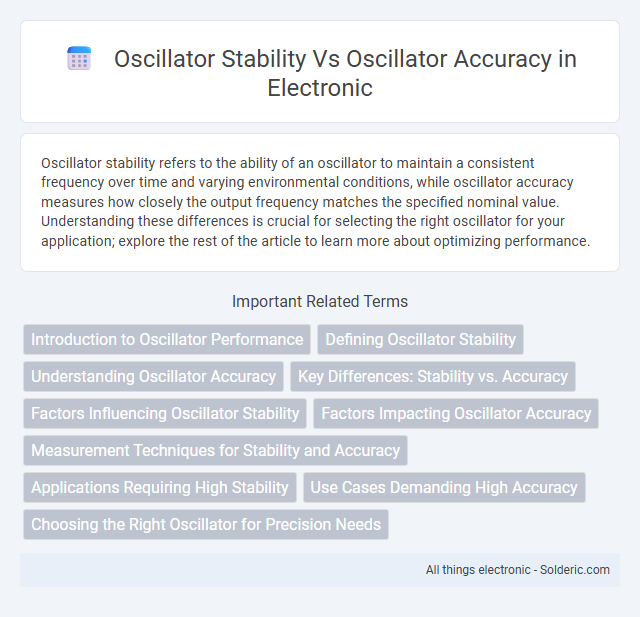Oscillator stability refers to the ability of an oscillator to maintain a consistent frequency over time and varying environmental conditions, while oscillator accuracy measures how closely the output frequency matches the specified nominal value. Understanding these differences is crucial for selecting the right oscillator for your application; explore the rest of the article to learn more about optimizing performance.
Comparison Table
| Aspect | Oscillator Stability | Oscillator Accuracy |
|---|---|---|
| Definition | Ability to maintain consistent frequency over time and environmental changes | Closeness of oscillator's output frequency to its nominal or specified frequency |
| Measurement | Frequency variation (ppm or ppb) over time, temperature, voltage | Frequency error (%) or ppm from target frequency at a specified condition |
| Factors Affecting | Temperature changes, aging, power supply fluctuations, mechanical stress | Component tolerances, initial calibration, manufacturing precision |
| Typical Metrics | Short-term vs long-term stability, Allan deviation | Initial frequency tolerance, calibration error |
| Impact | Ensures reliable and predictable oscillator performance over time | Determines how close the oscillator output is to the desired frequency initially |
| Examples | Temperature-compensated crystal oscillator (TCXO), oven-controlled crystal oscillator (OCXO) | Standard crystal oscillator with specified frequency accuracy |
Introduction to Oscillator Performance
Oscillator stability refers to the ability of an oscillator to maintain a consistent frequency over time and environmental changes, while oscillator accuracy measures how close the output frequency is to the desired or nominal frequency at a given moment. Your system's performance heavily depends on both stability and accuracy, as high stability ensures reliability over long durations and varying conditions, whereas high accuracy ensures precise frequency output initially. Understanding both parameters is crucial for applications demanding precise timing, such as communication systems and signal processing.
Defining Oscillator Stability
Oscillator stability refers to the ability of an oscillator to maintain a consistent frequency over time and varying environmental conditions, such as temperature, pressure, and supply voltage changes. It is a measure of how much the output frequency deviates from its nominal value during continuous operation, which directly impacts system reliability and signal integrity. Your choice of an oscillator with high stability ensures minimized frequency drift, essential for precision applications like communication systems and timing devices.
Understanding Oscillator Accuracy
Oscillator accuracy defines how closely the output frequency matches the desired or nominal frequency, primarily influenced by factors such as crystal quality, manufacturing tolerances, and temperature variations. High accuracy ensures reliable timing performance in applications like communication systems and instrumentation, where precision is critical. While stability measures frequency consistency over time and conditions, accuracy directly impacts the correctness of the initial frequency setting.
Key Differences: Stability vs. Accuracy
Oscillator stability refers to the oscillator's ability to maintain a consistent frequency over time and varying environmental conditions, while oscillator accuracy describes how closely the oscillator's output frequency matches the intended or reference frequency at a specific moment. Stability impacts the long-term reliability and performance of your system, minimizing frequency drift due to temperature changes, aging, or supply voltage variations. Accuracy ensures that the initial frequency is precise, but without stability, even an accurate oscillator can lead to errors in applications requiring sustained timing precision.
Factors Influencing Oscillator Stability
Oscillator stability is primarily influenced by temperature variations, power supply fluctuations, and aging of components, which can cause frequency drift over time, while oscillator accuracy refers to how close the output frequency is to a specified nominal value. Crystal quality and packaging, environmental conditions, and circuit design also play critical roles in maintaining oscillator stability, ensuring consistent performance in your applications. High stability oscillators use temperature compensation and frequency control techniques to mitigate these factors and maintain precise frequency output.
Factors Impacting Oscillator Accuracy
Oscillator accuracy depends on factors such as temperature variations, supply voltage fluctuations, and manufacturing tolerances, which cause frequency deviations from the nominal value. Aging effects lead to gradual frequency shifts over time, impacting long-term accuracy. Material properties and environmental conditions, including humidity and mechanical vibrations, also play critical roles in maintaining oscillator precision.
Measurement Techniques for Stability and Accuracy
Oscillator stability measurement techniques primarily involve Allan deviation and phase noise analysis, which quantify frequency fluctuations over time and short-term noise characteristics respectively. Accuracy is typically assessed using frequency counters and time interval analyzers against a calibrated reference standard, ensuring the oscillator's output matches the nominal frequency within specified limits. High-precision instruments like frequency synthesizers and spectrum analyzers enable detailed evaluation of both stability and accuracy to optimize oscillator performance in critical applications.
Applications Requiring High Stability
Applications requiring high oscillator stability, such as precision timekeeping, radar systems, and telecommunications, rely on oscillators that maintain a consistent frequency over long periods and varying environmental conditions. High stability minimizes frequency drift caused by temperature fluctuations, aging, and supply voltage variations, ensuring reliable signal integrity and synchronization. Oscillator accuracy addresses initial frequency deviation but does not guarantee long-term consistency critical for stable operation in advanced scientific instruments and satellite communications.
Use Cases Demanding High Accuracy
Oscillator stability ensures consistent frequency output over time and environmental changes, critical in long-term applications like telecommunications and GPS systems. Oscillator accuracy defines how close the oscillator's output frequency is to its nominal value at a given instant, essential in precision measurement instruments and frequency synthesis. Your choice of oscillator depends on whether the use case demands steady performance or exact initial frequency alignment.
Choosing the Right Oscillator for Precision Needs
Oscillator stability measures how consistently it maintains frequency over time and varying conditions, while oscillator accuracy refers to how close the frequency is to its specified value at a given moment. For precision needs, prioritize an oscillator with high stability to ensure minimal drift during operation and select one with sufficient accuracy to meet initial frequency requirements. Your choice depends on balancing stable long-term performance with the exact frequency accuracy demanded by your application.
Oscillator stability vs Oscillator accuracy Infographic

 solderic.com
solderic.com